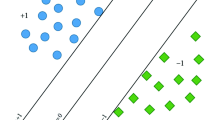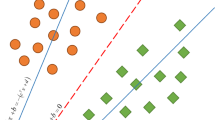Abstract
Universum data that do not belong to any class of a classification problem can be exploited to utilize prior knowledge to improve generalization performance. In this paper, we design a novel parametric ν-support vector machine with universum data (\( \mathfrak {U} \)Par-ν-SVM). Unlabeled samples can be integrated into supervised learning by means of \( \mathfrak {U} \)Par-ν-SVM. We propose a fast method to solve the suggested problem of \( \mathfrak {U} \)Par-ν-SVM. The primal problem of \( \mathfrak {U} \)Par-ν-SVM, which is a nonconvex optimization problem, is transformed into an unconstrained optimization problem so that the objective function can be treated as a difference of two convex functions (DC). To solve this unconstrained problem, a boosted difference of convex functions algorithm (BDCA) based on a generalized Newton method is suggested (named DC-\(\mathfrak {U} \)Par-ν-SVM). We examined our approach on UCI benchmark data sets, NDC data sets, a handwritten digit recognition data set, and a landmine detection data set. The experimental results confirmed the effectiveness and superiority of the proposed method for solving classification problems in comparison with other methods.










Similar content being viewed by others
References
Arabasadi Z, Alizadehsani R, Roshanzamir M, Moosaei H, Yarifard AA (2017) Computer aided decision making for heart disease detection using hybrid neural network-Genetic algorithm. Comput Methods Prog Biomed 141:19–26
AragónArtacho FJ, Vuong PT (2020) The boosted difference of convex functions algorithm for nonsmooth functions. SIAM J Optim 30(1):980–1006
Artacho FA, Campoy R, Vuong PT (2020) Using positive spanning sets to achieve d-stationarity with the boosted dc algorithm. Vietnam J Math 48(2):363
Artacho FJA, Fleming RM, Vuong PT (2018) Accelerating the DC algorithm for smooth functions. Math Program 169(1):95–118
Bazikar F, Ketabchi S, Moosaei H (2020) DC programming and DCA for parametric-margin ν-support vector machine. Appl Intell:1–12
Chapelle O, Agarwal A, Sinz F, Schölkopf B (2007) An analysis of inference with the universum. Adv Neural Inf Process Syst 20:1369–1376
Chen X, Yang J, Liang J (2012) A flexible support vector machine for regression. Neural Comput Appl 21(8):2005–2013
Chicco D (2017) Ten quick tips for machine learning in computational biology. BioData Min 10 (1):35
Clarke FH (1990) Optimization and nonsmooth analysis. SIAM
Daniel WW (1990) Friedman two-way analysis of variance by ranks. Appl Nonparametr Stat:262–274
Ding S, An Y, Zhang X, Wu F, Xue Y (2017) Wavelet twin support vector machines based on glowworm swarm optimization. Neurocomputing 225:157–163
Ding S, Shi S, Jia W (2019) Research on fingerprint classification based on twin support vector machine. IET Image Process 14(2):231–235
Ding S, Zhang N, Zhang X, Wu F (2017) Twin support vector machine: theory, algorithm and applications. Neural Comput Appl 28(11):3119–3130
Dua D, Graff C UCI machine learning repository (2019). https://archive.ics.uci.edu/ml
Friedman M (1940) A comparison of alternative tests of significance for the problem of m rankings. Ann Math Stat 11(1):86–92
Hao PY (2010) New support vector algorithms with parametric insensitive/margin model. Neural Netw 23(1):60–73
Hiriart-Urruty JB, Strodiot JJ, Nguyen VH (1984) Generalized Hessian matrix and second-order optimality conditions for problems with c1,1 data. Appl Math Optim 11(1):43–56
Hsu CW, Chang CC, Lin C et al (2003) A practical guide to support vector classification
Iman RL, Davenport JM (1980) Approximations of the critical region of the fbietkan statistic. Commun Stat-Theory Methods 9(6):571–595
Jayadeva KR, Chandra S (2007) Twin support vector machines for pattern classification. IEEE Trans Pattern Anal Mach Intell 29(5):905–910
Ketabchi S, Moosaei H (2012) Minimum norm solution to the absolute value equation in the convex case. J Optim Theory Appl 154(3):1080–1087
Ketabchi S, Moosaei H, Razzaghi M, Pardalos PM (2019) An improvement on parametric ν-support vector algorithm for classification. Ann Oper Res 276(1-2):155–168
LeCun Y, Boser BE, Denker JS, Henderson D, Howard RE, Hubbard WE, Jackel LD (1990) Handwritten digit recognition with a back-propagation network. In: Advances in neural information processing systems, pp 396–404
Lee YJ, Mangasarian OL (2001) RSVM: Reduced support vector machines. In: Proceedings of the 2001 SIAM International Conference on Data Mining. SIAM, pp 1–17
Li M, Yu X, Ryu KH, Lee S, Theera-Umpon N (2018) Face recognition technology development with gabor, pca and svm methodology under illumination normalization condition. Clust Comput 21 (1):1117–1126
de Lima MD, Costa NL, Barbosa R (2018) Improvements on least squares twin multi-class classification support vector machine. Neurocomputing 313:196–205
Mangasarian OL, Wild EW (2005) Multisurface proximal support vector machine classification via generalized eigenvalues. IEEE Trans Pattern Anal Mach Intell 28(1):69–74
Moosaei H, Musicant D, Khosravi S, Hladík M (2020) MC-NDC: multi-class normally distributed clustered datasets. Carleton College, University of Bojnord. https://github.com/dmusican/ndc
Musicant D (1998) NDC: normally distributed clustered datasets
Noble WS, et al. (2004) Support vector machine applications in computational biology. Kernel Methods Comput Biol 71:92
Pardalos PM, Ketabchi S, Moosaei H (2014) Minimum norm solution to the positive semidefinite linear complementarity problem. Optimization 63(3):359–369
Qi Z, Tian Y, Shi Y (2012) Twin support vector machine with universum data. Neural Netw 36:112–119
Schölkopf B, Smola AJ, Bach F, et al. (2002) Learning with kernels: Support vector machines, Regularization, Optimization, and Beyond. MIT Press
Schölkopf B, Smola AJ, Williamson RC, Bartlett PL (2000) New support vector algorithms. Neural Comput 12(5):1207–1245
Tanveer M, Khan MA, Ho SS (2016) Robust energy-based least squares twin support vector machines. Appl Intell 45(1):174–186
Tanveer M, Richhariya B, Khan R, Rashid A, Khanna P, Prasad M, Lin C (2020) Machine learning techniques for the diagnosis of alzheimer’s disease: A review. ACM Trans Multimed Comput Commun Appl (TOMM) 16(1s):1–35
Tao PD, et al. (1996) Numerical solution for optimization over the efficient set by dc optimization algorithms. Oper Res Lett 19(3):117–128
Tian Y, Qi Z (2014) Review on: twin support vector machines. Ann Data Sci 1(2):253–277
Vapnik V, Chervonenkis A (1974) Theory of pattern recognition. Moscow, Nauka
Wang H, Zhou Z, Xu Y (2018) An improved ν-twin bounded support vector machine. Appl Intell 48(4):1041–1053
Weston J, Collobert R, Sinz F, Bottou L, Vapnik V (2006) Inference with the universum. In: Proceedings of the 23rd International Conference on Machine Learning, pp 1009–1016
Xiao Y, Wen J, Liu B (2020) A new multi-task learning method with universum data. Appl Intell:1–14
Xu Y (2016) K-nearest neighbor-based weighted multi-class twin support vector machine. Neurocomputing 205:430–438
Yang Z, Xu Y (2016) Laplacian twin parametric-margin support vector machine for semi-supervised classification. Neurocomputing 171:325–334
Yang Z, Xu Y (2018) A safe sample screening rule for laplacian twin parametric-margin support vector machine. Pattern Recogn 84:1–12
Zhao J, Xu Y, Fujita H (2019) An improved non-parallel universum support vector machine and its safe sample screening rule. Knowl-Based Syst 170:79–88
Acknowledgements
The work of H. Moosaei and M. Hladík was supported by the Czech Science Foundation Grant P403-18-04735S.
Author information
Authors and Affiliations
Corresponding author
Ethics declarations
Competing interests
The authors declare that they have no conflicts of interest.
Additional information
Publisher’s note
Springer Nature remains neutral with regard to jurisdictional claims in published maps and institutional affiliations.
Rights and permissions
About this article
Cite this article
Moosaei, H., Bazikar, F., Ketabchi, S. et al. Universum parametric-margin ν-support vector machine for classification using the difference of convex functions algorithm. Appl Intell 52, 2634–2654 (2022). https://doi.org/10.1007/s10489-021-02402-6
Accepted:
Published:
Issue Date:
DOI: https://doi.org/10.1007/s10489-021-02402-6




